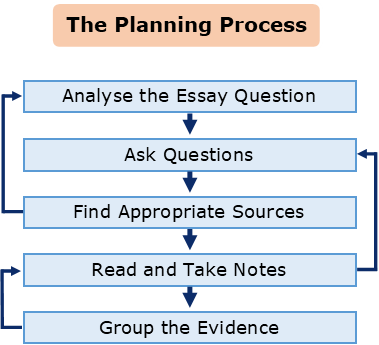Which tips make for effective essay body sections?

This is the fourth and final chapter About Body Paragraphs. To complete this reader, read each chapter carefully and then unlock and complete our materials to check your understanding.
– Remind the reader of the purpose of body paragraphs
– Explore seven tips for writing effective body sections
– Offer free activities and materials to measure academic comprehension and progress
Before you begin reading...
-
video and audio texts
-
knowledge checks and quizzes
-
skills practices, tasks and assignments
Chapter 4
In this fourth and final chapter about body paragraphs, we provide and explore the seven best tips for writing effective body sections in academic essays. After completing this final chapter, you may wish to unlock and download our worksheets to check your progress and understanding – or take one of our related short readers on introductory paragraphs or conclusions.
Tip 1: Follow the Planning Process
There’s lots to do before you even get to writing the body section of an academic essay, and it’s important that students decide the planning process that works best for them and stick closely to that process. If you haven’t yet settled on a system that works for you, the following flow diagram may assist your planning processes:

Of course, as the body is the most important section of an essay, this is the section you should be writing first – and the one that will require the most editing and proofreading. The introduction, on the other hand, should be saved until last, once your argument structure is fully decided, researched and drafted.
Tip 2: Include the Key Essay Elements
As was explored in Chapter 2 of this short reader, there are a number of key essay elements that students should make sure they include if they wish to write a successful academic essay. Such elements should be considered for all sections of an essay, whether it’s the thesis statement of an introduction, the supporting details of the body or the research gaps in the conclusion:

Once you’ve had lots of practice at writing essays, you’ll of course realise that there is some flexibility to how these elements are included. For newer academics, however, it’s recommended that you include these elements as carefully and considerately as you can to improve the overall cohesion and coherence of your writing – and therefore, your grade.
Tip 3: Maintain a Clear Argument
As the primary purpose of an essay is to clearly, concisely and logically convince your reader of a viewpoint or argument, it’s very important that as the writer you maintain that argument clearly throughout your essay. While the vast majority of the argument and it’s evidence is written within the body paragraphs, it is critical that your reader is informed of (and reminded about) your argument structure at various occasions throughout your essay.
In the introduction, this means contextualising the topic in the background information, introducing that topic specifically in the thesis statement, providing the concise main ideas of your argument in the outline and including any stance (opinion) that you may have as the writer. In the body, the topic and stance is then repeated in the topic sentence of each body paragraph, in which the main ideas are explored in the same order as provided in the outline for logic and consistency. The supporting details should then explore these main ideas with focus and relevance with the final summary-transition sentence either reminding the reader of that paragraph’s main idea or preparing them for the main idea of the next paragraph.
Finally, the thesis restatement of the conclusion should reiterate the essay’s topic before the summary of ideas reminds the reader of the key arguments and their findings as presented and ordered in the body section. By maintaining the clarity and consistency of your argument structure in this way, you will assist the coherence and cohesion of your essay by helping the reader to navigate your essay and remember its key arguments and opinions.

Tip 4: Limit the Main Ideas
One issue that many students have when writing body paragraphs is that they tend to draft muddled paragraphs that contain too many main ideas and not enough supporting evidence. As body paragraphs should only be between 200 and 250 words in length on average, a paragraph that contains too many main ideas will not have a sufficient word count to allow for a deep enough investigation of the argument topic.
Because a shallow investigation will only lower your overall grade, it is recommended that you focus on one main idea per body paragraph and investigate that idea in depth. While two main ideas is acceptable also in some cases, as the writer you must make sure that these two main ideas are sufficiently connected in theme so that they clearly belong in the same body paragraph.
Tip 5: Provide Sufficient Support
Once you have settled on your argument structure and precisely which main ideas you will be investigating in each body paragraph (as well as how many ideas per paragraph, see Tip 4), the next tip is to make sure that you’ve provided ample support so that your investigation is thorough and not cursory. Generally, this means providing at least two to three pieces of supporting evidence, including potentially multiple supporting elements such as evidence, examples and explanation. As can be seen in the following sample paragraph (repeated from Chapter 2 of this reader), students should also remember to include implications in their own voice to further explain this support to the reader, informing them of its connection to the main idea:
[TOPIC SENTENCE] One commonly highlighted positive impact of global warming is the possible increase in plant-life in cold regions of the planet.8 [SUPPORTING DETAIL 1] [EVIDENCE] Butler (2017) argues that by 2030 there will be 8% more arable land available in areas that have historically been too cold for agriculture.9 [EXAMPLE] For example, uninhabited parts of Siberia may become more likely to have wide expanses of fertile and farmable land.10 [EXPLANATION] White (2018) claims that regions such as Siberia could experience an agricultural boom, and that climate change in this respect may encourage different migration patterns for both humans and animals.11 [IMPLICATION] From this perspective, global warming is not necessarily a threat to humanity and the Earth.12 [SUPPORTING DETAIL 2] [EVIDENCE/EXAMPLE] Similarly, Jenkins (2013) suggests that the arctic tundra will see an increase in plant reproduction, which will almost certainly result in new species emerging within that region.13 [EXPLANATION] However, scientists such as Jenkins also acknowledge that the regions to which they are referring are often those which ‘do not receive a significant amount of sunlight’ (White, 2018, p. 09).14 [IMPLICATION] Therefore, in terms of agricultural land, these areas cannot be considered a viable option to replace current land.15 [SUMMARY-TRANSITION SENTENCE] Ultimately, the argument that global warming will provide life new opportunities is not yet well developed.16
Tip 6: Balance Source/Writer Voice
The penultimate (2nd to last) tip in this chapter is about making sure that you balance the voice in your essay. As our short reader on balancing voices explains in significant detail, a body paragraph should be a balance of source voice, mixed voice and writer voice depending on the elements being included, who is providing the information, and the referencing practices that acknowledge the source-based details. A topic sentence, for example, should usually be in the Writer Voice, while a piece of evidence such as a fact or statistic would normally be taken from a source and would thus be presented in Source or Mixed Voice.
Tip 7: Edit and Proofread Carefully
Finally, before submitting your essay, remember to edit and proofread all sections of that essay very carefully – particularly your body section. This means making sure that you are using appropriate academic language, that your citations and references are present and accurate, that you have included cautious hedging language to protect yourself as an academic, that you have carefully selected which reporting verbs introduce your source-based information and claims, and that your writing is concise and logical. A body section that is carefully edited for all of these elements has a much higher likelihood of academic success (and of receiving higher grades).

To reference this reader:
Academic Marker (2022) About Body Paragraphs. Available at: https://academicmarker.com/essay-writing/body-paragraphs/about-body-paragraphs/ (Accessed: Date Month Year).
Downloadables
Once you’ve completed all four chapters in this short reader About Body Paragraphs, you might then wish to download our Chapter Worksheets to check your progress or print for your students. These professional PDF worksheets can be easily accessed for only a few Academic Marks
Chapter 1 explores the topic: What is the body section of an academic essay? Our Chapter 1 Worksheet (containing guidance, activities and answer keys) can be accessed here at the click of a button.
Chapter 2 explores the topic: Which elements build successful body paragraphs? Our Chapter 2 Worksheet (containing guidance, activities and answer keys) can be accessed here at the click of a button.
Chapter 3 explores the topic: Which academic phrases belong in an essay body? Our Chapter 3 Worksheet (containing guidance, activities and answer keys) can be accessed here at the click of a button.
Chapter 4 explores the topic: Which tips make for effective essay body sections? Our Chapter 4 Worksheet (containing guidance, activities and answer keys) can be accessed here at the click of a button.
To save yourself 3 Marks, click on the button below to gain unlimited access to all of our About Body Paragraphs Chapter Worksheets. This All-in-1 Pack includes every chapter, activity and answer key related this topic in one handy and professional PDF.
Collect Academic Marks
-
100 Marks for joining
-
25 Marks for daily e-learning
-
100-200 for feedback/testimonials
-
100-500 for referring your colleages/friends